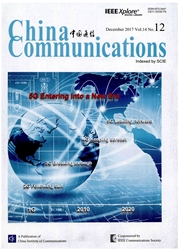

 中文摘要:
中文摘要:
In the last decade,cognitive radio(CR) has emerged as a major next generation wireless networking technology,which is the most promising candidate solution to solve the spectrum scarcity and improve the spectrum utilization.However,there exist enormous challenges for the open and random access environment of CRNs,where the unlicensed secondary users(SUs) can use the channels that are not currently used by the licensed primary users(PUs) via spectrum-sensing technology.Because of this access method,some malicious users may access the cognitive network arbitrarily and launch some special attacks,such as primary user emulation attack,falsifying data or denial of service attack,which will cause serious damage to the cognitive radio network.In addition to the specifi c security threats of cognitive network,CRNs also face up to the conventional security threats,such as eavesdropping,tampering,imitation,forgery,and noncooperation etc..Hence,Cognitive radio networks have much more risks than traditional wireless networks with its special network model.In this paper,we considered the security threats from passive and active attacks.Firstly,the PHY layer security is presented in the view of passive attacks,and it is a compelling idea of using the physical properties of the radio channel to help provide secure wireless communications.Moreover,malicious user detection is introduced in the view of active attacks by means of the signal detection techniques to decrease the interference and the probabilities of false alarm and missed detection.Finally,we discuss the general countermeasures of security threats in three phases.In particular,we discuss the far reaching effect of defensive strategy against attacks in CRNs.
 英文摘要:
英文摘要:
In the last decade,cognitive radio(CR) has emerged as a major next generation wireless networking technology,which is the most promising candidate solution to solve the spectrum scarcity and improve the spectrum utilization.However,there exist enormous challenges for the open and random access environment of CRNs,where the unlicensed secondary users(SUs) can use the channels that are not currently used by the licensed primary users(PUs) via spectrum-sensing technology.Because of this access method,some malicious users may access the cognitive network arbitrarily and launch some special attacks,such as primary user emulation attack,falsifying data or denial of service attack,which will cause serious damage to the cognitive radio network.In addition to the specifi c security threats of cognitive network,CRNs also face up to the conventional security threats,such as eavesdropping,tampering,imitation,forgery,and noncooperation etc..Hence,Cognitive radio networks have much more risks than traditional wireless networks with its special network model.In this paper,we considered the security threats from passive and active attacks.Firstly,the PHY layer security is presented in the view of passive attacks,and it is a compelling idea of using the physical properties of the radio channel to help provide secure wireless communications.Moreover,malicious user detection is introduced in the view of active attacks by means of the signal detection techniques to decrease the interference and the probabilities of false alarm and missed detection.Finally,we discuss the general countermeasures of security threats in three phases.In particular,we discuss the far reaching effect of defensive strategy against attacks in CRNs.
 同期刊论文项目
同期刊论文项目
 同项目期刊论文
同项目期刊论文
 Fairness guaranteed joint CRE and eICIC scheme for capacity improvement in two-tier heterogeneous ne
Fairness guaranteed joint CRE and eICIC scheme for capacity improvement in two-tier heterogeneous ne The asymptotic throughput and connectivity of cognitive radio networks with directional transmission
The asymptotic throughput and connectivity of cognitive radio networks with directional transmission 期刊信息
期刊信息
